Physical Address
304 North Cardinal St.
Dorchester Center, MA 02124
The gastrointestinal (GI) tract is the only internal organ with its own nervous system, known as the enteric nervous system (ENS), which is concealed entirely within the gut wall and can function fully independently of any neural inputs from the central nervous system (CNS). What is particularly unique about the ENS and the GI tract compared to all other organs is that it is capable of responding to sensory stimuli in vitro (without an involvement from any extrinsic afferents) and can generate complex neurogenic motor patterns, even when isolated from the animal. It is sometimes overlooked, but the ENS is itself an entire division of the autonomic nervous system and has developed all the neural circuits necessary to not only respond to sensory stimuli but also trigger polarized polysynaptic neural pathways that lead to muscle contraction oral to and relaxation anal to physiological stimuli. Activation of enteric neural circuits, following local stimulation in vitro, is sufficient to propel ingested contents along the isolated bowel.
The ENS has evolved not only in the GI tract of vertebrates but also in tiny invertebrates, like flies. For example, a prominent ENS has developed in the GI tract of the fly Drosophila melanogaster , and there is compelling evidence that the same neurotransmitters that are expressed in larger vertebrates have also evolved in the ENS of invertebrates. This is supported by the finding that choline acetyl transferase (ChAT) is expressed in enteric neurons from the midgut of Drosophila and peristalsis occurs in this region. In recent years, much has been learnt about the development of the ENS in grasshoppers and locusts and while there are important differences between the ENS of vertebrates and invertebrates, there are also some very clear similarities emerging in terms of neurogenesis, migration, and differentiation of enteric neurons.
The importance of the ENS in normal day-to-day propulsion of colonic content is perhaps best exemplified in genetic diseases like Hirschsprung's disease, where the GI tract develops without any enteric ganglia in the terminal part of the colon and/or rectum. This region is referred to as the aganglionic region. But, interestingly, this aganglionic region still receives extrinsic spinal efferent and afferent nerve inputs. And, interestingly, within the aganglionic region interstitial cells of Cajal (ICC), which are intestinal pacemaker cells, still develop. However, by themselves, ICC and smooth muscle cells are unable to propel contents sufficiently, leading to improper transit. The outcome is that newborn mammals born with Hirschprung's disease fail to develop the necessary propulsive neurogenic motor patterns, and typically megacolon develops. Without resection, mammals with large aganglionic segments of bowel typically die shortly after birth. While it is well acknowledged that inputs from the CNS are not required for the activation of enteric neural pathways and propulsion of intestinal content, there is extensive neural innervation and control of the ENS by central pathways arising from spinal cord.
The ENS composed of two discrete plexuses: one known as the myenteric plexus (originally called Auerbach's plexus), which lies between the two major muscle layers (the circular and longitudinal muscle coats) of the GI tract. The major function of the myenteric plexus is to generate neurogenic contractions and relaxations of the smooth muscle layers that are vital for the coordinated timing and genesis of neurogenic motor patterns, necessary for propulsion of ingested contents. The other nerve plexus that comprises the ENS is known as the submucosal plexus (originally called Meissner's plexus). This plexus is largely associated with secretomotor reflexes and absorption. In some parts of the GI tract, like the stomach, there is no submucosal plexus and motor reflexes and propulsion still occur. In these regions, it is thought that the myenteric plexus takes on the role of the submucosal plexus.
There are literally hundreds of thousands of nerve cell bodies within the myenteric and submucosal plexuses. Individual neurons within each plexus are localized to small ganglia that also contain variable numbers of glial cells. Each ganglion consists of variable numbers of different functional classes of enteric neurons that are distributed in not opographical order throughout each plexus. Submucosal ganglia are noticeably smaller than myenteric ganglia and contain significantly fewer numbers of neurons. Also, each submucosal ganglion is further spaced apart from one another when compared to ganglia in the myenteric plexus. Each ganglion, within the submucosal and myenteric plexus communicates to neighboring ganglia via synaptic connections, involving different neurotransmitters that generate fast and/or slow synaptic potentials. In the colon of mice, for example, there are ~ 40 rows of myenteric ganglia around the circumference of the colon and a similar number of rows of ganglia along every 6 mm of the length of colon (at resting length). This means that if one assumes each myenteric ganglion has on average 20 neurons, then for every 6 mm along the length of colon, there are ~ 32,000 myenteric neurons. If one assumes the density of myenteric ganglia and number of myenteric neurons is similar along the full length of colon (which is ~ 7 cm in length at rest), then this means there are ~ 370,000 myenteric neurons in the mouse colon.
The first morphological identification of enteric neurons was made in the late 1800s by Dogiel and La Villa. At first, Dogiel devised a particular nomenclature, which consisted of Type I, Type II, and Type III neurons. Later, he modified this classification to include Types IV-VII neurons. Nowadays, enteric neurons are most commonly classified morphologically into one of two major classes, either Dogiel Type I or Dogiel Type II. Neurons with Dogiel Type I morphology consist of relatively small cell bodies, with dendrites that do not project far from the cell soma and usually, a single long axon. A number of different functional classes of enteric neurons have morphologies consistent with Dogiel Type I neurons, including ascending and descending interneurons and inhibitory and excitatory motor neurons. A class of filamentous Dogiel Type I neurons has also been identified, which are also uniaxonal, but display extensive filamentous dendrites (see Fig. 14.1 ). Direct intracellular recordings from a population of filamentous interneurons in the distal colon have revealed that these neurons exhibit mechanosensory properties in response to maintained stretch.
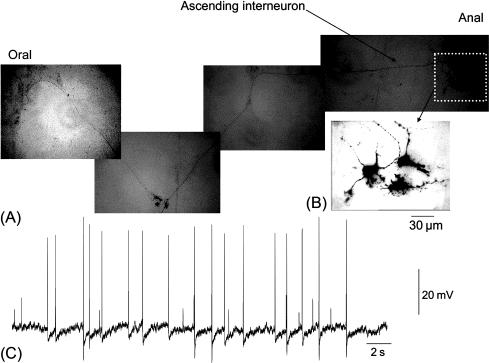
In contrast, Type II neurons have a very distinctive shape and projection profile. They have large smooth cell bodies, often oval in shape, that consist of many long branching axons that ramify extensively within myenteric ganglia. In the guinea pig small intestine, some Type II neurons have long aboral projections. The functional role of these outputs is not clear, but they may serve as a multifunctional neuron (e.g., interneuron), in addition to potentially fulfilling the role as an intrinsic sensory neuron.
The first known documented recordings from enteric neurons were made by Yokoyama in the mid-1960s. Although the morphological features and neurochemical coding of the neurons were unknown, Dr. Yokoyama had successfully recorded the electrical activity from neurons in the ENS, using extracellular electrodes in the isolated rabbit intestine. During his study, he was able to detect extracellular compound discharges of nerve action potentials, where it was stated that action potentials had a duration of about 20 ms. A few years later, Dr. Wood reported a more detailed description of the different patterns of neuronal firing within the myenteric plexus of the isolated cat intestine, where action potentials had a duration of 2–5 ms. In the rabbit, Yokoyama reported discharges of action potentials with an interval between bursts of 5 and 25 s and rhythmic segmental- type movements correlated with the nerve activity and not with the action potentials in the longitudinal muscle. In the cat, the average interval between bursts was 6.9 s. The study of Dr. Wood was highly significant because it was the first to demonstrate that enteric neurons could respond to mechanical stimuli with bursts of action potentials ( Fig. 14.2 ). He showed that both phasic- and tonic-type discharges of action potentials could occur and when mechanical stimulation was imposed on the myenteric ganglion by withdrawing the suction electrode, a tonic discharge of action potentials was elicited.
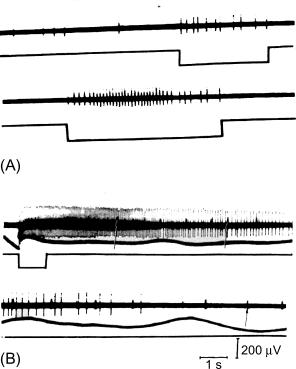
The first detailed intracellular recordings from myenteric neurons were made coincidentally by two independent laboratories, one in the northern hemisphere and the other in the southern hemisphere. Essentially, the two laboratories revealed very similar findings. That is, they identified two distinct populations of myenteric neurons based on electrical responses to current injection and the synaptic inputs they received in response to electrical stimulation of neighboring fiber tracts. Both studies agreed that one major type of cell fired tonically to current injection and received prominent fast synaptic inputs. These were called S-type neurons by or Type I neurons by, whereas the second population that rarely responded with any synaptic inputs to electrical stimulation, consistently generated a prolonged after hyperpolarization that ensured following single-action potentials. These were called Type II neurons by Dr. North's laboratory or after-hyperpolarizing (AH) neurons in the laboratory of Hirst et al. Also, Dr. Hirst noted in their experiments that it was not possible “… to evoke any synaptic activity in AH cells by transmural stimulation of the plexus, and no spontaneous synaptic activity has ever been recorded from these cells.” They suggested that “…that AH neurones, in common with primary afferent neurones, may not be innervated.” At the same time, Nishi and North also made the comment “…that the cells with the slow after-hyperpolarization do not have synaptic inputs, are compatible with the hypothesis that they are in the afferent side of an intramural reflex…” While there was no doubt that neural reflexes could be elicited by local stimulation of isolated segments of bowel, it had not been demonstrated that these reflexes were generated by sensory neurons, whose cell bodies resided within the gut wall. It was conceivable, at that time, that axon collaterals of extrinsic spinal afferent axons, whose nerve endings resided within the gut wall, but whose cell bodies resided in dorsal root ganglia (DRG) could initiate neural reflexes in isolated segments of bowel.
It was not until 1995 that evidence emerged for the existence of a population of enteric neurons that had sensory properties. This was demonstrated when all synaptic transmissions were blocked in the ENS (using a tissue bathing solution of reduced extracellular calcium to block synaptic transmission), and it was demonstrated that under these conditions, exogenous serotonin (5-HT) puffed onto the mucosa elicited proximal process potentials in the cell somas of myenteric AH neurons. Later, a similar type response was demonstrated in the proximal colon, when electrical stimulation was applied to the mucosa and proximal process potentials were evoked in mucosally projecting Dogiel Type II neurons. Proximal process potentials occur in neuronal cell bodies when action potentials, which have been generated in the neurites, fail to elicit an action potential in the cell body. Unlike synaptic potentials that vary considerably in amplitude in the cell soma, proximal process potentials are of the same amplitude and do not increase in amplitude with an imposed membrane hyperpolarization (which is the opposite of fast EPSPs). The conclusion to these experiments was that the nerve endings of Dogiel Type II neurons (which project into the mucosa) can be directly excited by chemosensory stimuli, without relying on synaptic inputs from any other classes of neurons. This was taken as the first evidence that a population of sensory neurons exists in a peripheral organ. Based on these findings, the laboratory of Dr. Furness coined the terminology “Intrinsic Primary Afferent Neuron (or IPAN),” to represent myenteric Dogiel Type II (AH) neurons, which responded directly to mechanical and/or chemosensory stimuli, without synaptic transmission.
The notion that a population of sensory neurons exists within the ENS has not been fully accepted by all investigators. Dr. Wood has suggested that the terminology of IPAN “…is inaccurate because AH neurons are not sensory afferent neurons.” He suggests that justification for naming these neurons IPANs, based on data showing a paracrine activation of AH neurons by 5-HT is insufficient and suggests that “…AH neurons are interneurons that are synaptically connected for feed-forward excitation of neighboring AH neurons in driver circuits.” Indeed, morphologically, it is clear that AH neurons have extensive ramifications within myenteric ganglia onto other enteric neurons and some have long aboral projections for many millimeters. Since the original work of Nishi and North and Hirst et al. has been revealed that some AH neurons do receive fast synaptic inputs ( Fig. 14.3 ), which are mediated by nicotinic receptors.
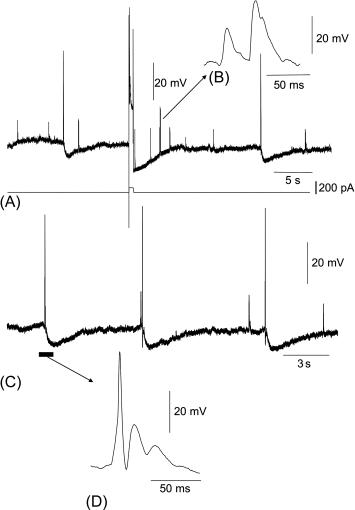
To test the hypothesis that a population of intrinsic sensory neurons exists within the wall of the GI tract, which could be capable of eliciting intrinsic neural reflexes, without any involvement from extrinsic afferents, segments of guinea pig intestine were extrinsically denervated (in vivo) about 9–11 days before the bowel was resected from the animal. The success of the denervation was performed histochemically to show degradation of extrinsic axons in the gut wall. When these preparations of intestine were removed from the animal, it was revealed that ascending and descending reflexes could still be readily elicited in the circular muscle, even though all extrinsic nerves had been histologically depleted. This data revealed that in the absence of all extrinsic afferent endings in the gut wall, sensory stimuli applied in vitro could still evoke ascending excitatory and descending inhibitory pathways to the smooth muscle layers.
The mechanisms underlying mechanosensory transduction in the ENS of the colon have some significant differences compared to the small intestine, even within the same species. For example, in guinea-pig distal colon maintained circumferential stretch evokes an ongoing discharge of ascending excitatory and descending inhibitory nerve pathways, which fire simultaneously in the circular ( Fig. 14.4 ) and longitudinal muscle layers. This stretch-activated motor pattern did not require extrinsic capsaicin-sensitive afferents and was unaffected by muscle paralysis with an L-type Ca 2 + channel blocker. Clearly, in the distal colon, a population of sensory neurons must not require muscle tone or tension for the mechanotransduction of stretch-activated firing of ascending excitatory and descending inhibitory pathways in the ENS. In contrast to the distal colon, in the guinea-pig ileum, paralysis of muscle tone or tension has a major effect to reduce mechanosensitivity of intrinsic sensory neurons. The mechanisms underlying the discrepancy of mechanotransduction between the two regions are not understood.
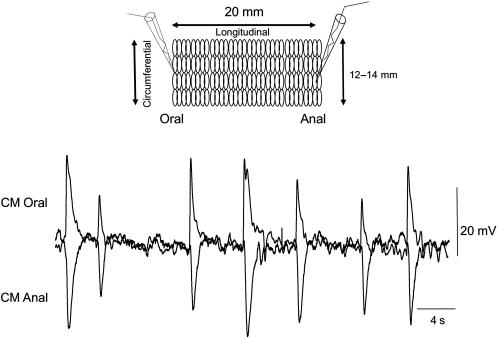
What is clear is that in the guinea-pig distal colon, the stretch-activated repetitive firing of ascending excitatory and descending inhibitory neural pathways were resistant to muscle paralysis, suggesting that a fundamentally different process was required for sensory neuronal transduction than was identified for the muscle tension-sensitive activation of myenteric AH neurons in the small intestine. Interestingly, in these paralyzed preparations of distal colon, direct recordings from myenteric AH neurons revealed this class of neuron was electrically silent at the same time as these stretch-activated pathways were active ( Fig. 14.5 ). However, in these stretched segments of guinea-pig distal colon, a population of myenteric neurons was recorded from the guinea-pig colon, which were activated by circumferential stretch, even in the presence of a low Ca 2 + solution (to prevent all synaptic transmission). These neurons were identified as interneurons with extensive dendritic morphology and with S-class electrophysiology, which received prominent fast synaptic inputs and fired tonically to current injection, but also generated proximal process potentials. This finding provided support for the idea that a population of interneurons may serve a dual function, not only to transmit synaptic traffic along the length of bowel but also to respond directly to mechanical stimuli. Neuronal imaging data from Dr. Schemann's laboratory further support the idea that a population of intrinsic sensory neurons could be multifunctional neurons. Their work identified rapidly adapting mechanosensitive enteric neurons which were called (RAMEN). In the guinea-pig small intestine, these neurons comprised 25% of all neurons in the myenteric plexus. It was found that RAMEN were activated with phasic action potential discharge pattern to deformation of the ganglion, and this response was suggested to be reproducible and increased as the applied force increased. Interestingly, of all RAMEN tested 72% were cholinergic, 22% were nitrergic, and 44% were identified to express NeuN and calbindin, two reliable markers of IPANs. Mechanosensitivity was observed in 31% and 47% of retrogradely traced interneurons and motor neurons, respectively. Because it was found that a substantial population of myenteric neurons was interneurons or motor neurons, which still responded to von Frey hair compression, or intraganglionic volume injection, the team suggested that many neurons in the ENS are multifunctional mechanosensitive neurons (MEN). These investigators have now identified MENs not only in the guinea-pig ileum but also mouse ileum and colon and human intestine.
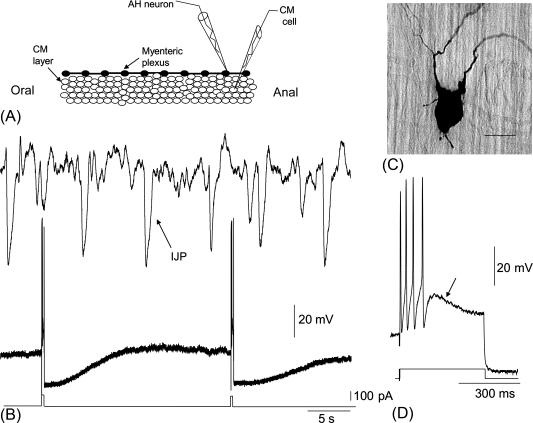
Unlike skeletal muscle that has only an excitatory innervation, smooth muscle of the GI tract is innervated by both excitatory and inhibitory motor neurons. There have been some important advances in our understanding of enteric motor neurons. One of the important advances was the discovery that enteric motor neurons to the longitudinal and circular muscle are indeed innervated by separate and distinct populations of motor neurons. This was first suspected when differences in neurotransmission were recorded during simultaneous intracellular recordings from the two muscle layers our understanding of the motor neuronal populations that innervate the circular and longitudinal muscle layers. Then, with the development of DiI retrograde tracing from the two distinct muscle layers, it was confirmed that indeed different populations of motor neurons innervate the two muscle layers of the bowel, with different projections and neurochemical characteristics. Longitudinal muscle motor neurons ramify in no preferential orientation around the circumference of the bowel, whereas circular muscle motor neurons have clear circumferential projections, and a single motor neuron to the circular muscle can typically innervate about one-third of the circumference of the bowel. In human colon, the projections of circular muscle motor neurons are very similar to those in laboratory animals. That is, the excitatory circular muscle motor neurons project locally, or orally for short distances (typically < 2 mm) and contain ChAT, while inhibitory circular muscle motor neurons typically project short distances anally and contain the enzyme nitric oxide synthase (NOS) and often vasoactive intestinal peptide (VIP).
In response to maintained circumferential stretch of the bowel, studies have now shown that common interneurons synapse onto both distinct populations of inhibitory and excitatory motor neurons. This was demonstrated when stretch-evoked discharges of inhibitory junction potentials (IJPs) were found to be linearly related in amplitude, even though no electrotonic coupling existed between the two layers. This was supported by the finding that when IJPs occurred simultaneously in both the circular and longitudinal muscles, application of a nitric oxide synthesis inhibitor blocked the slow IJP in the longitudinal muscle, but the prominent fast apamin-sensitive IJP in the circular layer was not detected passively propagating in longitudinal cells.
A most interesting recent advance in our understanding of enteric motor neurons is that a population of NOS immunoreactive Dogiel Type I neurons responded directly to mechanical stimuli. This population likely includes inhibitory motor neurons, which can therefore be presumed to be potentially “multifunctional neurons.” Indeed, it had been suspected for some time that a population of enteric motor neurons may exhibit mechanosensitive properties, and hence may be capable of releasing neurotransmitter when all known excitatory synaptic inputs to these neurons had been blocked. This notion had emerged as an example, in the guinea-pig distal colon where acetylcholine appeared to be able to be released onto the smooth muscle in stretched colonic preparations, even in the presence of hexamethonium when all synaptic transmission in the ENS had been prevented. This was realized when atropine potently reduced circular muscle tone of the colon, even though these same reparations had nicotinic transmission blocked.
Traditionally, enteric interneurons were thought of as neurons that simply receive synaptic inputs from either other interneurons or sensory neurons, then relay synaptic outputs (excitatory or inhibitory) to either other interneurons, or motor neurons in ascending or descending pathways along the bowel. This notion has been revised in recent years. Nowadays, a picture has emerged that a population of interneurons are multifunctional and can likely serve roles as both a sensory neuron and interneuron. As mentioned, in the guinea-pig distal colon maintained circumferential stretch evokes sensory responses in a population of myenteric interneurons. These interneurons have extensive dendritic processes that ramify throughout the ganglion of origin ( Fig. 14.1 ). Based on immunohistochemical staining techniques, in the guinea-pig distal colon, there are four major neurochemical classes of descending interneuron and three major classes of ascending interneuron. In the guinea-pig ileum, there is reported to be only one major class of ascending interneuron, from which detailed electrophysiological characteristics have been obtained. No mechanosensory properties were identified in ascending interneurons of the guinea-pig ileum. However, they do receive prominent fast nicotinic synaptic inputs predominantly from other ascending pathways. In contrast to only one class of ascending interneuron in the guinea-pig ileum there are four major classes of descending interneuron in this region, based on neurochemical classification. In the human colon, there are two major types of ascending interneuron. One type which comprises 90% of all ascending interneurons contains ChAT, while the remainder contain neither NOS or ChAT. There are three major classes of descending interneuron in the human colon, the greatest population contains NOS, but interestingly lack ChAT. 5-Hydroxytryptamine-like immunoreactivity has been identified in a small population of enteric neurons of human foetuses, but no evidence has been revealed that 5-HT is a neurotransmitter in human ENS, since all synaptic inputs are blocked by hexamethonium.
An important advance in our understanding of the control of excitability of specific classes of enteric neurons was made when it was discovered recently that calcium/calmodulin- dependent protein kinase II was found to be colocalized in myenteric neurons of guinea-pig, human, rat, and mouse intestine. It was revealed that CaMKII expression was localized in myenteric neurons expressing calretinin and NOS and noncholinergic secretomotor neurons of the submucosalplexus. When CaMKII activity was blocked with the selective inhibitor KN-62, it caused a suppression of slow excitatory postsynaptic potentials and prevented tetrodotoxin-induced increases in contractility, suggesting that tonic neurogenic inhibition in the colon is dependent upon CaMKII-signaling pathways. Interestingly, CaMKII signaling acted to suppress purinergic slow synaptic potentials that have been shown to be mediated by the P2Y1 receptor on submucosal neurons. Fast synaptic transmission in the ENS involves P2X receptors, and P2X7 are highly expressed on neurons expressing calbindin, calretinin, neuropeptide Y, substance P, and NOS.
There have been some important advances in our understanding of submucosal neurons in recent years. These neurons are well known to play a major role in electrolyte and water secretion. In a recent study, it was demonstrated that the properties of submucosal neurons ad their control of epithelial ion transport changed along the length of the colon. Also, the size of submucosal ganglia decreased, at the same time as the proportion of cholinergic neurons actually increased along the length of colon. In mice, a pronounced difference between the submucosal plexus compared to other species is the overt lack of intrinsic sensory neurons. The functional ramifications of this are unclear. What is clear is that the colonic migrating motor complex (CMMC), which is a major colonic motor pattern in the isolated whole mouse, can be reliably generated without the submucosal plexus; and mucosa and only requires an intact myenteric plexus and smooth muscle layers.
There have been some important advances in our understanding of synaptic transmission in the submucosal plexus. A study showed that neurally released nitric oxide acts to increase the amplitude of inhibitory postsynaptic potentials (IPSPs) in submucosal neurons, but likely acts to depress the amplitude of slow excitatory postsynaptic potentials (slow EPSPs).
Recent studies have investigated the effects of cholera toxin (CT) on excitability of submucosal neurons. While it is well known that the hypersecretion induced by cholera toxin requires activation of secretomotor neurons, the classes of neurons affected by CT are incompletely understood. In isolated segments of jejunum from guinea pigs, a recent study showed perhaps surprisingly, that submucosal neurons were unaffected, but myenteric neurons showed hyperexcitability. This increase in excitability of myenteric AH neurons was found to be dependent upon NK3 receptors, but not ligand-gated 5-HT3 receptors.
Become a Clinical Tree membership for Full access and enjoy Unlimited articles
If you are a member. Log in here